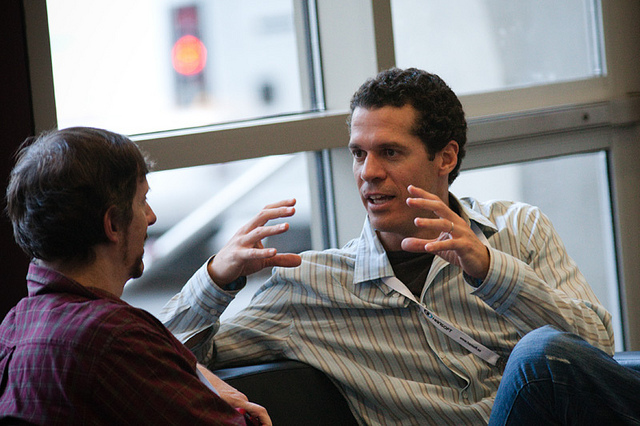
Say What You Mean, Mean What You Say
Say What You Mean, Mean What You Say https://csuiteold.c-suitenetwork.com/wp-content/uploads/2014/09/say.jpg 640 426 C-Suite Network https://csuiteold.c-suitenetwork.com/wp-content/uploads/2014/09/say.jpgby Judith Glaser

Our least-developed skill is the ability to confront each other face to face, say what is in our hearts and minds and, at the same time, build and strengthen our relationships. Confrontation is something we tend to avoid.
Having difficult conversations scares most people into thinking they will lose a friendship, so they avoid the truth. When we feel frustrated or angry at someone we feel has undermined us, we get so upset we just can’t find the words to express ourselves. We end up pushing, not pulling, expressing our worst behaviors — or we may hold it all inside until we boil up and explode.
We now know from Conversational Intelligence research we’ve conducted for the past five years that conflict, or even “fear of conflict,” causes our brains to produce higher levels of cortisol, the fear hormone. Cortisol is like a red light to our brains; it closes down the part of our brain where language resides (the prefrontal cortex), and we lose our ability to express ourselves clearly or accurately.
Since much of what goes on in situations with high emotional content occurs in our minds and produces this powerful hormone, we discover that we start to “make stuff up” as we search for the way to describe how we feel. We are no longer in reality; we are in “our story.” Even if the story is not true, it is how we have come to put words to the drama of our experience. Much of our frustration comes from the words we use to tell the story.
Meaning Matters
How do we communicate with each other when we feel pushed to the edge? How do we deal with these challenges to build relationships rather than erode them? How do we masterfully walk ourselves down the ladder of conclusions instead of climbing the ladder of assumptions, inferences and stories about each other that only reinforce our separateness rather than our connectivity?
Imagine you have just been recruited onto a project team, only to discover that among your team members is someone you don’t get along with at all. She was one of those people who talked about others behind their backs and couldn’t hold confidences.
You start to remember what it was like working with her, and your blood boils. You wonder how she could have been chosen for this project. You just don’t trust this person. You feel that she’s out to win for herself. Your dreams about being on an exciting project team are crumbling.
In an ideal world, we get to choose the people we want to work with. It starts with choosing a company, a boss and teammates. Yet today, as teams are formed, we are often dropped into an ongoing drama where there is baggage. You may know some people from previous situations or heard about them from colleagues and friends. They may remind you of the father you never got along with or of your difficult college roommate.
Searching for Comparables
When traveling from one situation to the next, you bring your past along to guide your way. You tap into points of view, know-how, likes and dislikes and rules of conduct, giving you the conceptual tools to decide what to do and why.
Rather than entering a new situation with an unbiased and open mind, you search for comparables. You go into your memory bank of similar examples and bring them up to uncover the rules, interpretations and understandings you need. You have a dialogue with yourself, and perhaps others, about what this new situation will be like, drawing on your past knowledge, insight and wisdom. Patterns from the past invisibly surface. You may call upon comparables from your experience or from things you’ve read or heard to help you navigate new terrain. Data from the past is either valuable, or it gets in the way.
For example, following an acquisition, one leader wanted to launch his team with the best resources and wisdom possible. Yet, it’s hard to predict how individuals will respond. Acquisitions and mergers trigger every territorial instinct we have — from who will get the best and biggest office, to who will be promoted, demoted or let go. We quickly shower the new situation with baggage from the past.
So, the leader decided to run a Team Journey. He designed a Learning Journey to preserve the best of what their team had been, and let go of the obstacles and limiting beliefs that would no longer serve them in the future. Within seven months, they produced results that exceeded their year-end expectations.
Conversations for Holding on OR Letting Go
The consequences of your interactions are filed daily in your memory bank, either as “feel good” or “feel bad” experiences. Memories with strong emotions linger, since the brain more easily files and calls up memories attached with strong sensory data. With little provocation, we can instantly call up a bad experience. Haven’t you ever had a bad experience with a boss? If you’re really upset, you’ll talk about it forever. Emotional trauma or experiences that threaten our ego, well-being and self-esteem, or just push our hot buttons, tend to linger and create toxic effects that, over time, become the stories everyone wants to tell.
Culture develops through storytelling, and stories are a primary “currency” for entering each other’s space of intimacy. We share our wounds and hope for a compassionate response back. On the other hand, letting go of the past and embracing the future frees energy that has been bound up in feelings of the past. Harboring bad feelings about others, and building cases about experiences long gone, only limits our ability to experience our own vitality. Bad feelings bring us down. Negative spirals produce more negativity in our lives. Letting go is the ability to interrupt the past and embrace the future.
Try This: What About You?
Think about the people on your team. Think about emotions that you experience when you’re with different team members. Think about how some conversations close you down, whiles others open you up.
- Based on how you are feeling, are you encouraging engagement and healthy conversations — or territorial and unhealthy conversations?
- Mark the relationships in which you may be participating in triangulation and case building. Are you opening up or closing down a relationship that is of great value to you?
- What tools and resources can you draw upon to give you insight and clarity into how to work more productively with team members?
Conversations that feel mean — producing cortisol — are like a “red light” that stops us from engaging with others in healthy ways. While conversations that feel good produce oxytocin, which opens us up to engagement, trust and innovation. Think about it… say what you mean, and mean what you say — but don’t be mean!
 Judith E. Glaser is the CEO of Benchmark Communications, Inc. and the Chairman of The Creating WE Institute. She is the author of the best selling book, “Conversational Intelligence” (Bibliomotion, 2013), an Organizational Anthropologist and a consultant to Fortune 500 companies.Visit her at creatingwe.com; conversationalintelligence.com or contact her at jeglaser@creatingwe.com. Follow Judith on Twitter @CreatingWE.
Judith E. Glaser is the CEO of Benchmark Communications, Inc. and the Chairman of The Creating WE Institute. She is the author of the best selling book, “Conversational Intelligence” (Bibliomotion, 2013), an Organizational Anthropologist and a consultant to Fortune 500 companies.Visit her at creatingwe.com; conversationalintelligence.com or contact her at jeglaser@creatingwe.com. Follow Judith on Twitter @CreatingWE.




